Note: This post was updated in September 2021.
With the garden planted, I’m eagerly awaiting the fruits of my labor: the first tiny, pea-sized tomato, a wisp of a bean, a green button of a pepper. Soon we will be enjoying these fruits and with a little seed-saving, we’ll have more to grow next year — and the year after that!
What to Save
Saving seed from open-pollinated or heirloom vegetables is pretty easy to do — although some vegetables require more time and space to gather “true-to-type” seeds. The good news is some of the most popular vegetables and flowers in the garden are also the some of the easiest to save seed from!
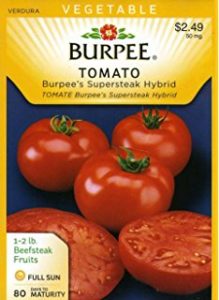
By law, seed companies must label hybrid seed packets. If it doesn’t have “hybrid” or “F1” on the packet it is not a hybrid.
Why Not Save Seed from a Hybrid? Well, you certainly can, however the plant that grows from a hybrid seed will be nothing like the parent plant. A hybrid (noted as “F1” on a seed packet), is the result of a cross-pollination of two or more cultivars to achieve some desired attribute, such as uniformity in shape, size, or disease resistance. Hybrids can take years for seed companies to develop and are often proprietary. It’s not that the seed won’t grow — it will, but the resulting plant won’t be like the original.
“Open-pollinated” generally refers to seeds that will “breed true.” When plants of an open-pollinated variety self-pollinate, or are pollinated by another plant of the same variety, the resulting seeds will produce true-to-type seeds, which produce plants that are roughly identical to the parent plant. This is how we achieve “heirlooms;” plant varieties that have been saved year after year and remain identical to the parent plant.
So What is an Heirloom? These open-pollinated varieties have a history of being passed down through generations. All heirlooms are open-pollinated, but not all open-pollinated plants are heirlooms. That’s because an heirloom must be 50 years old or more (this definition is loosely agreed upon by plant experts).
A Quickie on the Birds & the Bees
Plants reproduce through pollination and there are several ways this is accomplished. For “easy” seed-saving, we are interested in vegetables that self-pollinate. This means they don’t rely on insects, the wind, or man to get the job done — they do it themselves.
Tomatoes, peppers, eggplant, beans, peas, and lettuces all have perfect flowers — meaning the blossom contains both the male (anther) and female (stigma) flowering parts necessary for fertilization and fruit production.
With most of these vegetables, pollination occurs before the flowers even open — reducing the risk of cross-pollination from insects or wind — while greatly increasing the odds for true seed. But cross-pollination can happen, especially in lettuce and peppers, so there are a few things to do to ensure true seed.
Seed Saving Basics
The best way to obtain true seed is to only grow one type of cultivar. For example, only growing ‘Cherokee Purple’ tomatoes. Yeah, right. That will never work for me (and probably not for you either)!
Thankfully, there are other ways of achieving true seed when growing various cultivars together:
Isolation Distancing. Think of this as social-distancing for your plants. For most self-pollinating plants, the recommended isolation distance is 10 to 20 feet to prevent cross-pollination. Instead of planting all your tomato or pepper varieties in the same location, separate cultivars throughout the garden. Of course, isolation distancing needs to be planned before the garden is planted…so keep that in mind for next year!
Stagger Planting. Another technique is to stagger the planting times. This can be tricky with our relatively short growing season, but the idea is to plant different varieties a few weeks apart. This way some plants will have set fruit before others begin to flower.
Another way to approach this is to plant early-season varieties next to late or mid-season types. I’ve had great success doing this with early season ‘Sasha’s Altai’ and ‘Large Barred Boar’ tomatoes. Both produce flowers and set fruit before many other tomatoes in the garden; assuring me that these fruits have not been cross-pollinated.
These techniques are mostly suited to planting time. But is it possible to get true seed now, even if you have lots of different cultivars growing together? YES! Bring on the blossom bags…
Bagging & Other Diversion Tactics. These nifty little fabric bags slip over the flower bract of tomatoes and peppers to prevent insect cross-pollination. They are available from plant supply catalogs, but you can also find them at craft stores, since they also double as jewelry bags! And speaking of crafts, if you are handy with a sewing machine, you can make your own plant “covers” (or bags) from floating row material. These large covers are perfect for covering entire plants like peppers or lettuce.
Slip the bags over the blossom bract and leave it in place until the first tiny fruits are visible; then remove and tie a piece of string or colorful yarn to the bract, so you’ll know what fruits are for seed saving.
Another option that works well in conjunction with all these methods is to incorporate pollen-rich flowers between your rows of cultivars. The thought here is that the flower row will keep the pollinators off your veggie flowers and reduce the risk of cross-pollination. It’s less effective, but it will bring an additional layer of beauty to your garden!
The How To’s of Seed Saving
For the best seed saving results only save seed from healthy plants and choose the best fruits; gather seed from more than one plant for diversity; and only save seed from mature fruit (see note on peppers, below).
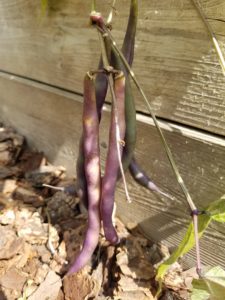
Beans can be left on the plant to dry completely or picked when “leathery” like these and be hung to dry.
Beans & Peas. The likelihood that beans or peas will be cross-pollinated by insects is very low due to the closed nature of the flower. However, if you are growing more than one cultivar for seed saving, you should distance plants at least 10 feet apart.
- When the pod is fully dry, split open and collect seed.
- Plants can be cut at the base or pods picked when “leathery” and hung to dry completely.
- Seed viability: 3 to 4 years.
Lettuce. For seed saving, plant lettuce in the late spring so flowers can develop while the temperatures are warm. When lettuce “bolts” it produces a flower stalk. Each flower contains one seed. To prevent cross-pollination cover the entire plant with a blossom cover and isolate plants 10 to 20 feet apart.
- Lettuce seed matures from the top down. Harvest individual seed heads and rub to remove seed or when 1/3 of seeds on the plant are mature, bend and shake into a bag.
- Seed viability: 6 years.
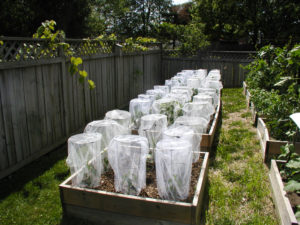
Floating row covers can be sewn into neat little bags to cover entire plants. This works great for peppers!
Peppers. Peppers are self-pollinators but are highly susceptible to cross-pollination from insects. Pepper blossoms should be bagged or entire plants covered to ensure true seed. The minimum isolation distance is 300 feet — so get your blossom bags ready!
- Seeds are mature when the pepper fruit ripens to its final color — which is not green! “Green” peppers are immature peppers. When fully ripe, a pepper may be red, yellow, orange, purple, or brown, but never green!
- Air dry thin-skinned peppers (many hot varieties) and crack open to collect seed. Wear gloves when handling any hot pepper variety. Drying time may take a few weeks or more depending on weather conditions. Check regularly when drying and discard any peppers that show sign of mold.
- Ripe, thick-walled peppers can be cut open and seeds scraped out. Let seeds air dry completely, out of direct sun for several days before storing.
- Seed viability: 2 to 4 years.
Tomatoes: I recommend saving seed from the very best tomatoes, but don’t despair, you can salvage the tomato for fresh eating or cooking.
- Choose mature fruit. When the tomato is ripe, the seeds are ready for harvesting.
- The best way to process tomato seeds is through fermentation:
Tomato seeds have a gelatinous covering that can inhibit germination. For that reason, the best way to save seed is through fermentation, which breaks down the gelatinous covering. The process is simple, albeit a little messy, and involves removing the seeds and pulp in to a container, adding a bit of water, and letting the mixture “ferment” for up to 72 hours (but no longer, as the seeds can begin to germinate).
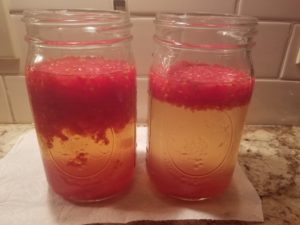
Initially the seed and pulp will float, but over time viable seed will sink to the bottom of the container.
A few times a day, stir the concoction. This helps break up the pulp and separate the seed out.
The pulp and any non-viable seed will float to the top, while the viable seed will sink to the bottom. Gradually add clean water and pour off the liquid until it is clear and only contains seeds. You may have to do this several times to remove all the pulp.
On the final “rinse” pour the seed in to a sieve and rinse well with water. Tap off excess water and place the seed on a plate in a single layer to dry, away from direct sunlight or heat. Store when completely dry.
- Seed viability: 4 to 6 years.
Herbs and Flowers
Cilantro, chives, dill and parsley will happily reseed themselves if the flower heads are left to ripen. To control self-seeding and the ensuing over-population crisis, cut mature seed heads and place them in a paper bag to dry completely. Seeds from annual flowers like calendula, marigolds, and sweet pea can be saved this way also. Simply collect dried seed heads or pods and remove the seeds, then dry and store until next spring.
Seed saving is easy, economical, and fun to do…and best of all, it provides you with an endless supply of seeds to grow and share!
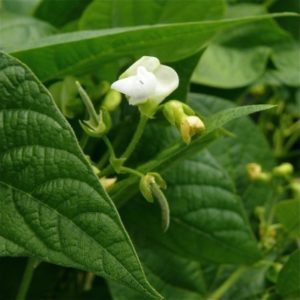
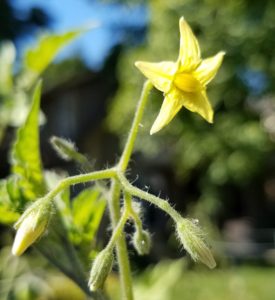
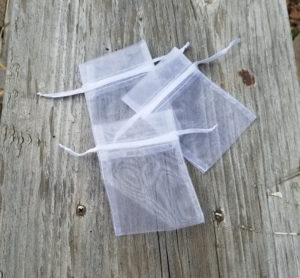
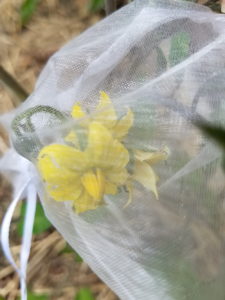
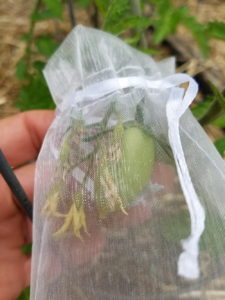
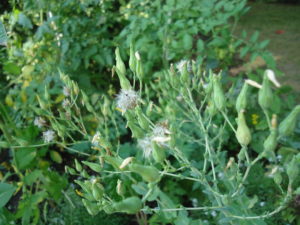
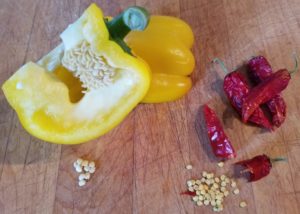





Do you recommend bag growing?
Sure! Grow bags are a great alternative to “pots” or in-ground growing. As with any plant grown in a container, you’ll want to make sure the plant is receiving adequate water and nutrients, but when you are short on space a grow bag is a great way to grow!
It all depends on whether the breeder wants pure material or genetically variable plants for future selection. Variety is the spice of life.